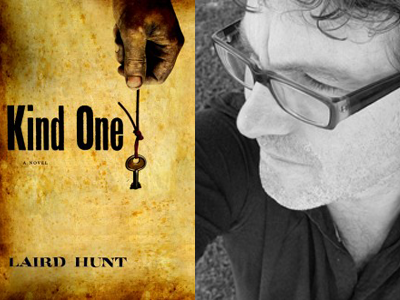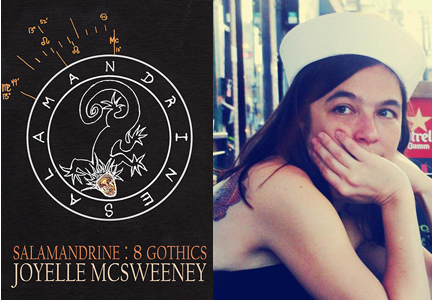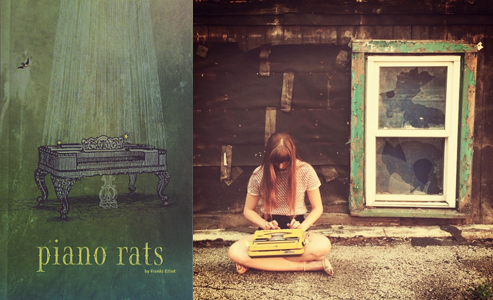Amid AWP Chicago, some of the loudest buzz was from the Rose Metal Press table, with much of the clamor centered around I Take Back the Sponge Cake, a book described as “A Lyrical Choose-Your-Own-Adventure” and lauded for its full-color production yet reasonable price-tag. Of course we had to get our hands on a copy, and now, having fully ingested this tremendous sponge cake, we need to know more about how it happened, where it came from, and as luck would have it, behind this book are two generous authors willing to talk with us about it.
 MB: As you write in the preface ‘The Making of I Take Back the Sponge Cake’, this collaboration was born out of a lucky convergence between two strangers at the Vermont Studio Center, both attending for one-year artist-staff residencies, but was it ‘love at first sight’, or did it take a bit more time to develop this newfound friendship into a working artistic relationship?
MB: As you write in the preface ‘The Making of I Take Back the Sponge Cake’, this collaboration was born out of a lucky convergence between two strangers at the Vermont Studio Center, both attending for one-year artist-staff residencies, but was it ‘love at first sight’, or did it take a bit more time to develop this newfound friendship into a working artistic relationship?
LE & SN: We definitely felt drawn to each other’s work right away, sensing an affinity in our images and styles in the different media, even sense of humor (which is important!). We both felt from the start a good potential for collaboration between us. But it was a bit of a slow build-up to get to the “relationship” part—the actual working together, determining how best to approach the project, and figuring out not only how to be creative together but also how to make decisions together and how to trust to bring the project to fruition. This also coincided with getting to know each other more as friends through our year in Vermont, and exploring our own individual practices as artists—the development of our collaboration seemed a natural part of this progression.
The relationship analogy does seem especially fitting for collaboration: starting with an “art crush” and liking each other as people—but also the willingness to give the time and effort needed to see if this can really go somewhere! Finding someone who has a compatible communication style, with a strong artistic vision who is also willing to let go and negotiate through the collaborative process, is also important—we feel like we really lucked out with each other!
MB: Also in that opening explanatory note we learn that the book didn’t really feel fully formed until you decided to implement the choose-your-own-adventure approach, bringing, as you call it, “the third catalyzing element” of the reader into play. Can you talk with us a little about how important the reader’s interaction with the text and images are for a book like I Take Back the Sponge Cake?
LE & SN: It was helpful for us to add an element of interactivity and play into the project through the choose-your-own-adventure structure—we hoped it would enhance the reader’s engagement with the work and make it more fun to read, but it also made it more fun for us too when putting it together. Read a poetry and art book, or go on an adventure? We wanted to choose both! And we feel like most of our readers will too.
We both share a great fondness for the Choose Your Own Adventure books we read as kids—it felt so exciting to decide your own way and to take an active role in how your reading experience would unfold. We wanted to bring that enjoyment into our collaboration. Plus what you see and read next means more when you have made the conscious choice to get there. When we do live readings from this book, we have the audience choose what we’ll read next by majority vote. You can feel the excitement and attention build as we make our way through the book together, aware of the possibilities and creating a particular trajectory—we hope something similar happens when people read on their own as well.
So much of our individual work has to do with our subjective experiences in this strange world. With the Choose-Your-Own-Adventure format we could allow the reader to construct their own subjective experience by journeying through the book. Thinking of the project in terms of a journey, in terms of various journeys, was exciting: at each juncture what turn would they take? And what did we want to place ahead of them for them to discover next? It felt like we were creating an imaginary landscape for them to explore.
MB: And while some may mistakenly view I Take Back the Sponge Cake as a collection of poetry with  accompanying illustrations, you make it abundantly clear that the images are in conversation with the text, and vice versa. Can you tell us a bit more about that process, about making art or texts that are in dialogue with one another rather than created as stand-alone entities?
accompanying illustrations, you make it abundantly clear that the images are in conversation with the text, and vice versa. Can you tell us a bit more about that process, about making art or texts that are in dialogue with one another rather than created as stand-alone entities?
LE & SN: Some collaborations between writers and visual artists have a more linear, and distanced, process—either the writing or the visual art is created first by one person, and then that work is used to inspire the other person and his/her medium. (Often with the words coming first, and the artwork created second as illustration.) But in our case, the collaborative process focused on immersion and conversation. It came more from finding where our existing work overlapped, bringing together those pieces that already seemed to share a world, and then generating more written work (collaboratively and individually) from inside that particular space.
It helped that the body of work we focused on from Loren’s art was her collection of individual drawings on pieces of 4” x 6” paper—about the same physical size as a short lyric poem. So as we began laying drawings and poems down side by side to determine the most interesting conversations and pairings, they visually seemed of the same world too, living in the same dimension, with similar proportions. For the poems we wrote together, we would usually write in Loren’s studio with all of her drawings pinned in a swarm on the wall beside us—allowing it to influence us, but not basing our writing on any one particular piece. And sometimes Sierra would take a group of Loren’s drawings to her studio (which was right next door), and use that batch as inspiration for a new poem.
Once we had generated a fair amount of poems, we came together to decide which image and poem pairing created the most interesting affinity and dialogue—and when the pairing felt right to both of us, we knew we had our answer. We followed the same process for mapping the trajectories: determining which homophone pair belonged with which page spread, and how each word felt to determine where it would lead next in the book. When we had differing ideas, we would discuss our views, and the dialogue between the work on the page reflects in part the dialogue between us—not as a record of debate, but more as an alignment of intuition.
MB: And even as much as I Take Back the Sponge Cake is a unified text by two authors, it contains numerous texts and images that allude to or focus on the idea of separation or the struggle for individual identity. For instance, the poem ‘Pseudomorph’:
Releasing a false body from my body
my shadow emerges and I am beside myself.
I am all startle and
stun, undone,
while she is all desire
a body of ink in water–
Or the image of ‘Jackpot Laundry Machine’: How important is separation and individual identity in terms of art and poetry, in terms of making a book like I Take Back the Sponge Cake?
How important is separation and individual identity in terms of art and poetry, in terms of making a book like I Take Back the Sponge Cake?
LE & SN: We weren’t thinking about these themes overtly as we collaborated, but it makes sense that they would emerge in both the writing and artwork, and how those two elements came together. The human desire to connect with others is a strong motivational force (for seeking love, for making art), as well as the desire to understand oneself and to create, which requires some separation to do the work, even loneliness or isolation. These two desires can help each other and deepen the experience of the other, but they also sometimes work in opposition.
Both of our individual studios practices often entail a good deal of time spent alone. This project required that we move beyond our individual practices without eclipsing them. Our separateness is just as important as our synthesis.
MB: Lastly, the choose-your-own-adventure structure of this is genius, and beautifully produced, but even with these directions:
If you become lost, or would like to return somewhere that you have already been, please refer to the map on page 52.
and the corresponding ‘Adventure Map’, is there any level of concern that readers might end up missing a poem or image by never taking a path that leads there? Or is that part of what I Take Back the Sponge Cake is about – finding your own way as a reader and then rifling back through the worn and unworn paths alike, seeking out each portion of the book as a whole, trying to locate each and every moment?
LE & SN: We hope people enjoy the book however they decide to interact with it—choosing (and re-choosing) their way through trajectories until they’ve explored all (or most) of them—following several adventures through, and then skipping around (or using the map) to see what possibilities they’ve missed—even reading the book straight through without making any choices. The active choice of the reader is an important part of the experience—in creating this choose-your-own-adventure structure, we trust that each reader will move through the work in the way that is most interesting and meaningful to them. And that makes it exciting for us too!
through trajectories until they’ve explored all (or most) of them—following several adventures through, and then skipping around (or using the map) to see what possibilities they’ve missed—even reading the book straight through without making any choices. The active choice of the reader is an important part of the experience—in creating this choose-your-own-adventure structure, we trust that each reader will move through the work in the way that is most interesting and meaningful to them. And that makes it exciting for us too!
I Take Back the Sponge Cake is a gorgeous book, one that offers amazing poetry and art while also saying so much about the possibilities of collaboration, and the fact that Rose Metal Press took on a project such as this and produced it as it deserved – in full-color and with beautiful stock – reminds us that so much brilliant goodness is on the horizon of our indie press landscape. Start your own Rose Metal Press adventure by picking up a copy of I Take Back the Sponge Cake here, & read more from / about Loren Erdrich and Sierra Nelson here.



